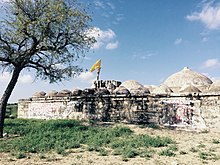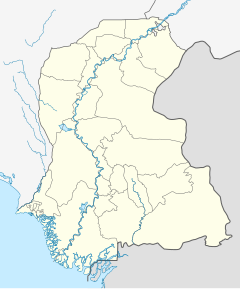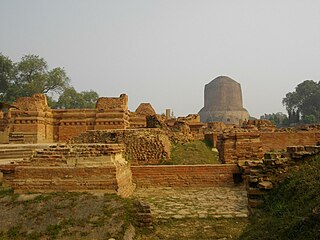
Sarnath is a place located 10 kilometres northeast of Varanasi, near the confluence of the Ganges and the Varuna rivers in Uttar Pradesh, India.
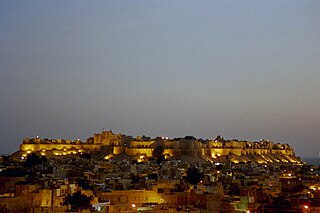
Jaisalmer, nicknamed "The Golden city", is a city in the Indian state of Rajasthan, located 575 kilometres (357 mi) west of the state capital Jaipur. It is the administrative headquarters of Jaisalmer District. Before Indian independence, the town served as the capital of the Jaisalmer State, ruled by the Bhati Rajputs. Jaisalmer stands on a ridge of yellowish sandstone and is crowned by the ancient Jaisalmer Fort. This fort contains a royal palace and several ornate Jain temples. Many of the houses and temples of both the fort and of the town below are built of finely sculptured sandstone. The town lies in the heart of the Thar Desert and has a population, including the residents of the fort, of about 78,000.

Karoonjhar Mountains are located in south-eastern edge of the Tharparkar district in Sindh, Pakistan. The range is approximately 19 kilometers long and reaches a height of 305 meters, and contains vaste deposits of granite and Chinese clay.

Nagarparkar, is a tehsil in at the base of the Karoonjhar Mountains in Tharparkar District in Sindh province of Pakistan. The historic Churrio Jabal Durga Mata Temple is situated here. The taluka is located at a distance of 129 km from Mithi, in Sindh, Pakistan.
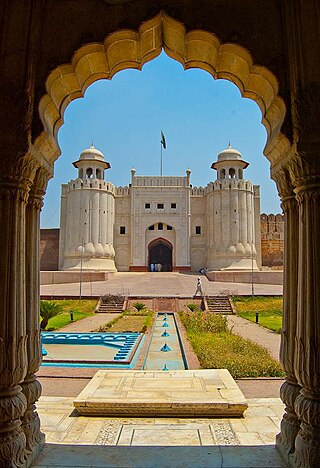
Tourism in Pakistan is a growing industry. In 2010, Lonely Planet termed Pakistan "tourism's 'next big thing'". The country is geographically and ethnically diverse, and has a number of historical and cultural heritage sites. Condé Nast Traveller ranked Pakistan The Best Holiday Destination for 2020 and also declared it the third-highest potential adventure destination in the world for 2020. As security in the country improves, tourism increases; in two years, it has increased by more than 300%. The Pakistani government had launched online visa services for 175 countries and 50 countries were offered visa on arrival, making visiting Pakistan easier. The country received an influx of travel vloggers, who promoted the characteristics of the country, such as in the Northern Pakistan, like Hunza and Skardu.
Pakistani architecture is intertwined with the architecture of the broader Indian subcontinent. The major architectural styles popular in the past were Temple, Indo-Islamic, Mughal and Indo-Saracenic architecture, all of which have many regional varieties. With the beginning of the Indus civilization around the middle of the 3rd millennium BC, for the first time in the area which encompasses today's Pakistan an advanced urban culture developed with large structural facilities, some of which survive to this day. This was followed by the Gandhara style of Buddhist architecture that borrowed elements from Ancient Greece. These remnants are visible in the Gandhara capital of Taxila.

Tharparkar, also known as Thar, is a district in Sindh province in Pakistan, headquartered at Mithi. Before Indian independence it was known as the Thar and Parkar or Eastern Sindh Frontier District (1882-1901).

Godiji Parshwanath is the name given to several images of the Jain Tirthankar Parshwananth in India, and to the temple where it is the main deity (mulanayaka). Parshwanath was the 23rd Tirthankara who attained nirvana in 777 BCE.

Tourism in India is economically important and ever-growing. The World Travel & Tourism Council calculated that tourism generated ₹14.02 lakh crore (US$180 billion) or 9.6% of the nation's GDP in 2016 and supported 40.343 million jobs, 9.3% of its total employment. The sector is predicted to grow at an annual rate of 6.8% to ₹28.49 lakh crore (US$360 billion) by 2027. Various states and union territories of India attract tourists from all over the world, mainly due to the cultural diversity.

Jain Basadi complex in Halebidu, Hassan district consists of three Jain Basadis dedicated to the Jain Tirthankars Parshvanatha, Shantinatha and Adinatha. The complex is situated near Kedareshwara temple and Dwarasamudra lake. The temple complex also includes a step well called Hulikere Kalyani.

The Nagarparkar Jain Temples are located in the region around Nagarparkar, in Pakistan's southern Sindh province. The site consists of a collection of abandoned Jain temples, as well as a mosque heavily influenced by the architectural style of the temples. Buildings in the region date from the 12th to the 15th centuries - a period when Jain architectural expression was at its zenith. Frescoes at the Gori Temple are the oldest Jain frescoes still in existence in the northern regions of the Indian subcontinent. The temples were inscribed on the tentative list for UNESCO World Heritage status in 2016 as the Nagarparkar Cultural Landscape.
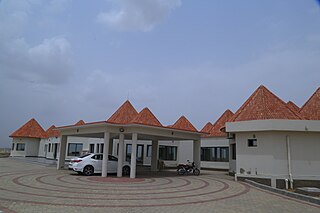
Rooplo Kolhi Resort is a resort in Nagarparkar, Sindh, Pakistan, owned by the Sindh Tourism Development Corporation situated at Islamkot Nagarparkar Road. The resort has a total 18 airconditioned, non-airconditioned, and single rooms.

Jain temples, Pavagadh is a group of seven Jain temples located in Pavagadh Hill in the state of Gujarat. These temples are part of the UNESCO World Heritage Site of Champaner-Pavagadh Archaeological Park.
